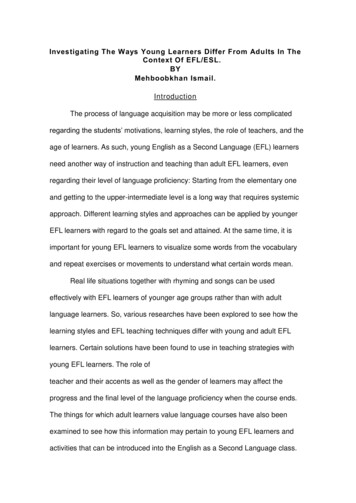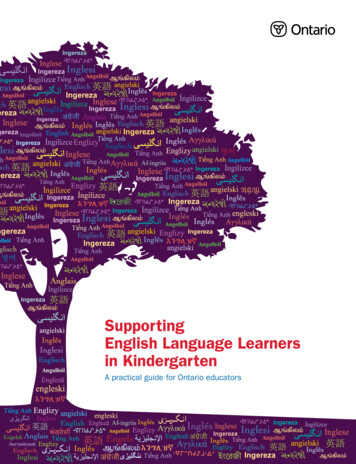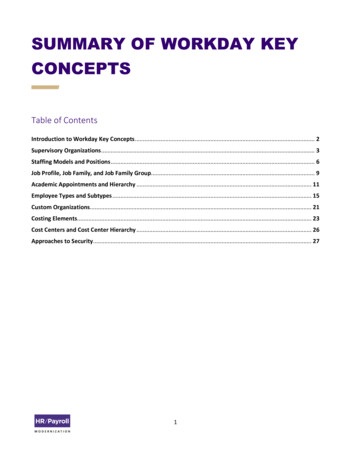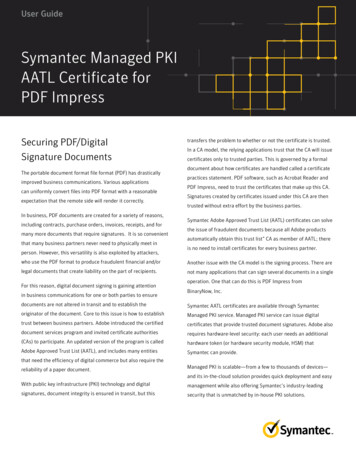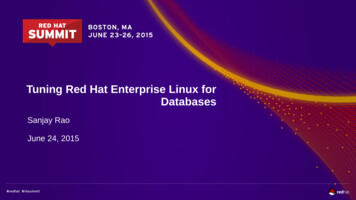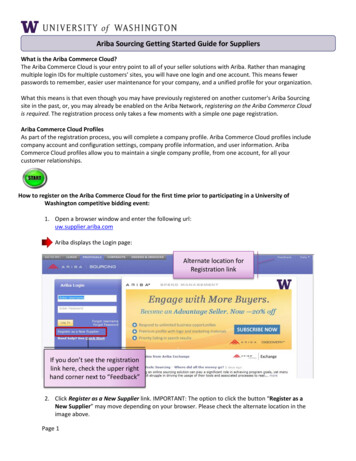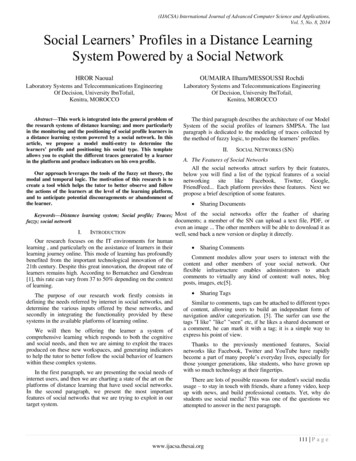
Transcription
(IJACSA) International Journal of Advanced Computer Science and Applications,Vol. 5, No. 8, 2014Social Learners’ Profiles in a Distance LearningSystem Powered by a Social NetworkHROR NaoualOUMAIRA Ilham/MESSOUSSI RochdiLaboratory Systems and Telecommunications EngineeringOf Decision, University IbnTofail,Kenitra, MOROCCOLaboratory Systems and Telecommunications EngineeringOf Decision, University IbnTofail,Kenitra, MOROCCOAbstract—This work is integrated into the general problem ofthe research systems of distance learning; and more particularlyin the monitoring and the positioning of social profile learners ina distance learning system powered by a social network. In thisarticle, we propose a model multi-entry to determine thelearners’ profile and positioning his social type. This templateallows you to exploit the different traces generated by a learnerin the platform and produce indicators on his own profile.The third paragraph describes the architecture of our ModelSystem of the social profiles of learners SMPSA. The lastparagraph is dedicated to the modeling of traces collected bythe method of fuzzy logic, to produce the learners’ profiles.Our approach leverages the tools of the fuzzy set theory, themodal and temporal logic. The motivation of this research is tocreate a tool which helps the tutor to better observe and followthe actions of the learners at the level of the learning platform,and to anticipate potential discouragements or abandonment ofthe learner.II.SOCIAL NETWORKS (SN)A. The Features of Social NetworksAll the social networks attract surfers by their features,below you will find a list of the typical features of a socialnetworking site like Facebook, Tiwtter, Google,FriendFeed. Each platform provides these features. Next wepropose a brief description of some features. Sharing DocumentsKeywords—Distance learning system; Social profile; Traces; Most of the social networks offer the feather of sharingdocuments; a member of the SN can upload a text file, PDF, orfuzzy; social networkI.even an image . The other members will be able to download it aswell, send back a new version or display it directly.INTRODUCTIONOur research focuses on the IT environments for humanlearning , and particularly on the assistance of learners in theirlearning journey online. This mode of learning has profoundlybenefited from the important technological innovation of the21th century. Despite this great innovation, the dropout rate oflearners remains high. According to Bernatchez and Gendreau[1], this rate can vary from 37 to 50% depending on the contextof learning.The purpose of our research work firstly consists indefining the needs referred by internet in social networks, anddetermine the various inputs offered by these networks, andsecondly in integrating the functionality provided by thesesystems in the available platforms of learning online.We will then be offering the learner a system ofcomprehensive learning which responds to both the cognitiveand social needs, and then we are aiming to exploit the tracesproduced on these new workspaces, and generating indicatorsto help the tutor to better follow the social behavior of learnerswithin these complex systems.In the first paragraph, we are presenting the social needs ofinternet users, and then we are charting a state of the art on theplatforms of distance learning that have used social networks.In the second paragraph, we present the most importantfeatures of social networks that we are trying to exploit in ourtarget system. Sharing CommentsComment modules allow your users to interact with thecontent and other members of your social network. Ourflexible infrastructure enables administrators to attachcomments to virtually any kind of content: wall notes, blogposts, images, etc[5]. Sharing TagsSimilar to comments, tags can be attached to different typesof content, allowing users to build an independant form ofnavigation and/or categorization. [5]. The surfer can use thetags "I like" "like" "seen" etc, if he likes a shared document ora comment, he can mark it with a tag; it is a simple way toexpress his point of view.Thanks to the previously mentioned features, Socialnetworks like Facebook, Twitter and YouTube have rapidlybecome a part of many people’s everyday lives, especially forthose younger generations, like students, who have grown upwith so much technology at their fingertips.There are lots of possible reasons for student's social mediausage – to stay in touch with friends, share a funny video, keepup with news, and build professional contacts. Yet, why dostudents use social media? This was one of the questions weattempted to answer in the next paragraph.111 P a g ewww.ijacsa.thesai.org
(IJACSA) International Journal of Advanced Computer Science and Applications,Vol. 5, No. 8, 2014B. The Sociol Needs of SurfersHyderKabani, Shaamah, author of The Zen of Social MediaMarketing [6], affirms the existence of two reasons that promptusers to integrate a social network: The expression of the identity: internet users need to puttheir identity in value, by trying to be better than other. The need to keep in touch with their friends and createnew bonds of friendship.Julie Schlack, Michel Jennings and Manila Austin [7] havealso cited six essential social needs which are pushing theinternet users to join a social network: Express their identities using the profiles. Help the others and ask them for help. Find people sharing the same center of interest. Create networks and a relationship with the each other. Develop a true sense of belonging to a community. Be reassured on their values, by having the feelingbeing useful and having influence on the world thatsurrounds them.Similar results have been deducted by a study made byDacharyCarey[8] : Help connected people. Search for the popularity.The social NeedsEach participant has a personal page, in which he canindicate the status of their work and the difficultiesencountered [10].Another experiment launched by a teacher from theUniversity of Vienna, who asks his students to makefeedbacks on his course through the site of micro-blogging inorder to assess the success of his lessons [12]. Build a community. Marketing The social needs of a learner vary from an online system toanother (learning platform, games application etc. ) and from acontext to another (obtain an academic degree, training oflanguage etc. ), also these needs vary between the systems oflearning and the sites of social networks. For this purpose, wehave proposed to classify them according to the diagram below(Figure 1): the degrees of the color of the arrows depict theimportance of the needIII.Fig.1.DISTANCE LEARNING PLATFORMS SUPPLIED BY ASOCIAL NETWORKThe integration of social networks in the platforms ofdistance learning is a recent approach; several works [9] [10][11] have been established on this new method of learning.Among these works, we cite the experience of the Universityof Leicester, one of these teachers has opened the socialnetwork “FriendFeed” with the students to provide them withinformation relating to the course - links, folders These experiences have highlighted the general results, likethe importance of the attendance rate of network, the regularityof connected pupils, the usefulness of the comments toimprove the job . [13].However, this information is still insufficient for the tutorto have a visibility on the social participation of the learner atthe level of the platform that will help him to better interveneduring the training.In our university, we work with the platform “Moodle “ ,a free, online Learning Management system[14] ,Technically,to satisfy our need to feed our distance learning platform"Moodle" with a social network, we have made studies aboutopen sources social networks; In the next paragraph, wepresent the summary of our research.IV.THE SOCIAL NETWORKS OPEN SOURCECurrently, several platforms of social networks are used.Below we show a few examples [15]:112 P a g ewww.ijacsa.thesai.org
(IJACSA) International Journal of Advanced Computer Science and Applications,Vol. 5, No. 8, 2014TABLE.I.THE PLATFORMS OF SOCIAL NETWORKS OPEN SOURCESSocialNetworkLangueElgg [16]EnglishApache,MySQL,PHPYesLowOxwall Compatibility HPYesStrong/English Make a thorough study of the features of social networksthe most used and identify internet users within theseenvironmentsMake a study on the social networks open sourceavailable, and make the choice of the socialnetworkthat best suits our needs. Integrate the social network to the platform used by theuniversity (Moodle). Experiment with the complete system Moodle socialnetwork(SocioMoodle) in a real context of training Analyze the collected data and calculate the socialindicators using our system SYMPA (system of modelingprofile learner)./ArabVI. Mahara is fully featured electronic portfolio, weblog;resume builder, and social networking system forconnecting users and creating online communities. Elgg is an open source social networking platformdeveloped for LAMP (Linux, Apache, MySQL, PHP)which encompasses weblogging, file storage, RSSaggregation, personal profiles, FOAF functionality andmore. Oxwall is a free and open source community softwaredistributed under the Common Public AttributionLicense. It is written in PHP and is used as a platformfor social networking and community sites. LiveStreet is open team collaboration software thatuses social networking to unify team workspaces,written in PHP, Javascript and MySQL.To make our choice, we define some important technicalvariables (Table 1) for the platforms previously presented.The decisive criterion of our choice was thedocumentation available on the integration of the socialnetwork chosen by the Moodle platform. For this, our choicehas focused on the Mahara platform; the integrationdocumentation is very available [ 19] ,and its features meetperfectly our needs.V.EXPERIMENTATIONSA. Target AudienceThe duration of our first experimentation was spread overthirty weeks with 140 learners. The first batch of students whohave made the experiment are the students of MQL (MasterQuality Software) graduation 2011/2012, they have worked onvaried subjects of application development. The second batchconcerned students from ENSA (National School of AppliedScience) graduation 2011/2012 who have all worked on somesubject of application development.The second experiment was conducted with the learners ofMQL (Master Quality Software) of Kenitra, graduation2012/2013, and the students of the ENSA (National School ofApplied Science) graduation 2012/2013, during a period of 14weeks. The tutor of MQL asked students to develop differentapplication by group, and the tutor of ENSA gave the samesubject, of application development, to all learners. To succeedour experiment, we asked learners to: To be connected daily to the platform. To created their public page on Mahara platform. To integrated their documents (Files,script,PDF ) onthe platform. To create a group for a work. To create a page of group on MaharaPROPOSALMany works in social psychology have highlighted theimpact of forms of interactions or social memberships on thecognitive mechanisms [20], as well as the importance of socialfactors in cognitive development, including the acquisition ofcultural knowledge [21].In this perspective, we propose to integrate the socialnetwork "Mahara" to our learning platform "Moodle", whichrenamed "SocioMoodle ", and we exploit the traces producedon this workspace to generate the new social indicators by oursystem SYMPA (System of modeling profile learner),and inorder to help tutor to make a best decision in the best time.For the establishment of our proposal, we have adopted thefollowing approach:VII. GENERAL PRESENTATION OF SYMPAA. Overview of SYMPAOur System of Modeling Profile Learner SYMPA, exploitsthe traces generated by the learners to produce socialindicators, which will help the tutor to identify a social profilefor each learner.The social profile of the learner depends on his socialproduction; it means by the number of Tags, comments, orsharing produced by the learner.Our SYMPA (Figure2) is composed of three components: acomponent which is engaged in the collection of the tracesgenerated by the learners, the second which is the treatment of113 P a g ewww.ijacsa.thesai.org
(IJACSA) International Journal of Advanced Computer Science and Applications,Vol. 5, No. 8, 2014traces and the calculations, and the lastgeneration of profiles.component for theIn particular, in the context of online education, it isinteresting to try to determine automatically profiles of socialbehavior among learners, as they can be useful both for thetutor and learners themselves.So each learner connected to the platform produces a set ofacts that we have previously presented (sharing tags, sharingdocuments, sharing comment). These acts are represented bythe traces; they are stored at the database level. Using oursystem SYMPA, will allow us to classify them according totheir types of actions and define profiles learners.For our case and based on the work of Plety [23], we havedefined three sets of profiles:TABLE.II.Fig.2.Modeling of SYMPAIn our case, the variable of the time is a parameter taken bythe component "treatment" in order to assess the profile of thelearner during the period of the training.THE PROFILES OF LEARNERS FOLLOWING A PERSONALSYNTHESIS OF THE WORK OF PLETY .ProfileMain Acts on theplatformVolume of participation of rCommentMedium/LowObserverTagsLowAfter the definition of the social profiles, with which wehave chosen to classify our learners, we present in the nextparagraph the steps of their modeling.B. The Socials Profiles LearnersWith the advent of Information and communicationtechnology (ICT), we talk about “Social Learning” whichallows the collaborative learning exchange betweenindividuals. Students learn how to communicate, eventually toreformulate for a better understanding. During thecollaborative learning, the exchanges resulting from it aresubstantial; they allow students to get feedbacks and get backto their learning. Through social networks, we will allow thelearners to be better at sharing and comparing their knowledge,offering a new style of dialogue.A. Presentation of the ModelingOur job is to analyze the traces generated at the level ofour experimentation {Tags (Tag), Comment (Cmt), Sahre(Prtg)}, and modeling the profile of the learner through the useof fuzzy set. For each element of the set {Tag,Cmt,Prtg}, wewill get a value that characterized the profile.Olivier Le Deuff[22] in an article in his blog"Guidedesegares.info" investigated on the concept of socialnetworks made for leisure, as new ways of learning. It showsthat people have developed skills beyond the mere techniquesof creative leisure. It shows that people can progress in thatfield and take part of it.The positioning of the learner profile according to the fuzzylogic is due to the combination of entered elements {Tag,CMT, Prtg} , with their degree of importance {Low, Medium,High}.Therefore, we can deduce that the innovation of distancelearning, using social networking encourages inter-studentinteractions between teachers and students; it also highlightsthe educational resources brought by digital platforms, whichprompt users to learn collaboratively.In a distance learning situation, the characteristics ofdifferent social behaviors are among learners. However,distance and media exchanges do not make as immediateperception of these social behaviors. To overcome thislimitation, we believe it is useful to have a computer systemthat can automatically analyze these behaviors.VIII. MODELING OF COLLECTING DATAThe choice of fuzzy logic for modeling the data collected isexplained by the relative nature of this data, which designateknowledge that is not perceived or defined clearly.B. Steps of Fuzzy Logic Step of FuzzificationThis step has for aim to transform the variables of digitalinputs in linguistic variables [24]. For our system we have asvariables of entered the values below:--Percentage of share Pctg(Prtg): It is the percentage ofdocuments that share a learner on the platform(Figure 3).Percentage of comments Pctg(CMT) : it is thepercentage of comments filed by a learner on theshared documents on the platform (Figure 4).114 P a g ewww.ijacsa.thesai.org
(IJACSA) International Journal of Advanced Computer Science and Applications,Vol. 5, No. 8, 2014-Percentage of tags Pctg(Tags): this is the percentageof tags that a learner has marked on documents orcomments shared on the platform (Figure 5).Under the fuzzy set associated to the output variable are{Observer, Evaluator, Producer}.The generation of the output variable is done by the systemby using the method of the center of gravity, depending on theresult, we determine the profile learner ( Figure 6).C. ResultsThe beaches of the results obtained according to thestatistics of our experimentation, are as follows (Figure 6):Fig.3.Between 0% and 35% the result is ObserverProfile.Between 30% and 70% the result is EvaluatorProfile.Between 65% and 100% the result is ProducerProfile.-Function belonging to Tags-Fig.4.Function belonging to ShareFig.5.Function belonging to CommentsTo give a tutor interface to observe the social profile ofeach learner, we develop a new model in the platform“Moodle”, in the Figure 7 an example of profile learneraccording to time, the blue color present “Observator Profile”,when the learner change the kind of contribution {Comment ,Share},the learner have a new Profile{Evaluator, Producer}.As output variable, we get the profile of the learner{Observer profile, Creator Profile, Producer Profile}, definedas follows (Figure 6).Fig.6.Fig.7.Function belonging to the output Step of Rules InferencesThe rules of fuzzy logic are of the form "If (X is A) then (Yis B) "with the fuzzy variable X which belongs to the Class Awith a certain degree of membership and in the same way, thevariable Y belongs to the class B with a degree of membership[25]. Below is sample of rules of our system:If (Percentage share is Low) and (Percentage Tag is Low) and(Percentage Comments is Fort)Then (Evaluator Profile)If (Percentage share is Strong) and (Percentage Tag is Low) and(Percentage Comments is Fort)Then (Producer Profile ) Step of DefuzzificationThe last step to have a blur system operational is called thedefuzzification. During the second step, it has generated a lotof commands in the form of linguistic variables (one commandper rule). The purpose of the defuzzification is to merge thesecommands and to transform the resultant settings into digitaldata [26].Viewing social profiles on MoodleIn addition, to validate our model, we have asked our tutorto make an assessment of their students and to assign a profileto each learner from their perceptions and what they observedduring experimentation.We have compared the experimental results obtained withthe perception of the tutor, and we have noticed a greatsimilarity in the results (table III).TABLE.III.LearnerCOMPARISON BETWEEN THE VALUES OF THE GUARDIAN ANDTHE MODEL OF POSITIONING123456789111111 1012345 6TutorO O P P O P PEEPOOPEP ESYMPAO P P P E O PEEPOOPPP EThe difference noticed between a few profiles of learnersdefined by the tutor, can be explained either by the timidity ofthe learners during the sessions of courses or directed tasks(case of learners 2, 5), the preferences for the use of the115 P a g ewww.ijacsa.thesai.org
(IJACSA) International Journal of Advanced Computer Science and Applications,Vol. 5, No. 8, 2014platform (case of learners 14), or technical problems on theplatform (case of learners 6).IX.CONCLUSIONIn this paper we presented a method for modeling socialprofile learner, in the “Moodle” system powered by the socialnetwork “Mahara”. Calculating the learner profile is influencedby among others inaccuracy, due to errors and approximationsinvolved in gathering information, for this we used the methodof fuzzy logic.In this article, we have also presented the results of ourexperiments to validate our model for positioning the socialprofiles of learners in distance education; our job is toguarantee a better analysis of the different tracks that wereproduced by students in our experiment, to generate socialindicators. With the help of our system SYMPA, the tutor canoptimize his interventions with the learners: motivate,encourage, warn he results of our experiments were encouraging, and theprofiles determined by the expert tutor were very close to thevalues given by our system SYMPA.[19][20]Our next goal is to analyze the traces obtained at theplatform for more social indicator of z, J. et Gendreau, L. (2005). L’opération « contrat deperformance » des universités québécoises : dans la perspective del’objectif de réussite étudiante.Rob Reinhardt ,2011 , About social community network featuresEncyclopedia Britannica, 2008. « Encyclopedia Article for blog »BoLeuf and WardCunningham. ,2002 , The WikiWay, by your hostsMonox,2010,Social Networking featuresShama Kabani’s book The Zen of Social Media: An Easier Way toBuild Credibility 2013.[22][23][24][25]Julie Wittes Schlack , Michael Jennings, Manila Austin « MeetingBusiness Needs by Meeting Social Needs in Small Communities,2007 ».Dachary, Use the Right Tools for the Job, March 9, 2010.Cédric Lemery, « Du web 2.0 à l’éducation 2.0 ? », 2007.Alan Cann, les réseaux sociaux améliorent la compréhension de laformation ,2010Jean-Paul Pinte, Les réseaux sociaux sont des outils d'apprentissage endevenir ,2009.Terry Anderson, Le Web 2.0, les réseaux sociaux et l’éducation. Lesenvironnements technologiques, les standards et les pratiquesinnovantes.2009Timothée Sicot, SMS et réseaux sociaux améliorent l’écriture desétudiants, 2013http://docs.moodle.org/27/en/FeaturesViva Logo Design Resources, 2011 Top 40 free downloadable opensource social networking softwareElgg - Logiciel de réseau social Open Source,2004Oxwall,Start a social network,a fan site,an education project withOxwall-fee open source community software,2010.LiveStreet CMS, LiveStreet CMS is a great tool to create socialnetworks and team blogs, 2010.Mahara, « Mahoodle :Integrating Mahara with Moodle »Sherif, M. et alii, 1988. The Robbers Cave Experiment: IntergroupConflict and Cooperation. Middletown (Conn.), Wesleyan UniversityPress.Doise, W. et Mugny, G., 1997. Psychologie sociale et développementcognitif. Paris, Armand Colin.Olivier Le Deuff ,2010 « Réseaux de loisirs créatifs et nouveaux moded’apprentissage», Distances et savoirs. Vol.8, n 4, p.601-621.Robert Pléty ,l’apprentissage coopérant, Ethologie et psychologie descommunications. [24]William DERIGENT, Vincent BOM BARDIER «Extraction de connaissances et reconnaissance Automatique d’entitésminces en aéronautique par Règles linguistiques floues» ; 11èmeColloque National AIP PRIMECA La Plagne - 22-24 avril 2009.Franck Dernoncourt, Le raisonnement en logique floue,2013Gerald huguenin, Processeurs Floushe-arc, baptiste savoye 26, ch-2610st-imie116 P a g ewww.ijacsa.thesai.org
License. It is written in PHP and is used as a platform for social networking and community sites. LiveStreet is open team collaboration software that uses social networking to unify team workspaces, written in PHP, Javascript and MySQL. To make our choice, we define some important technical
